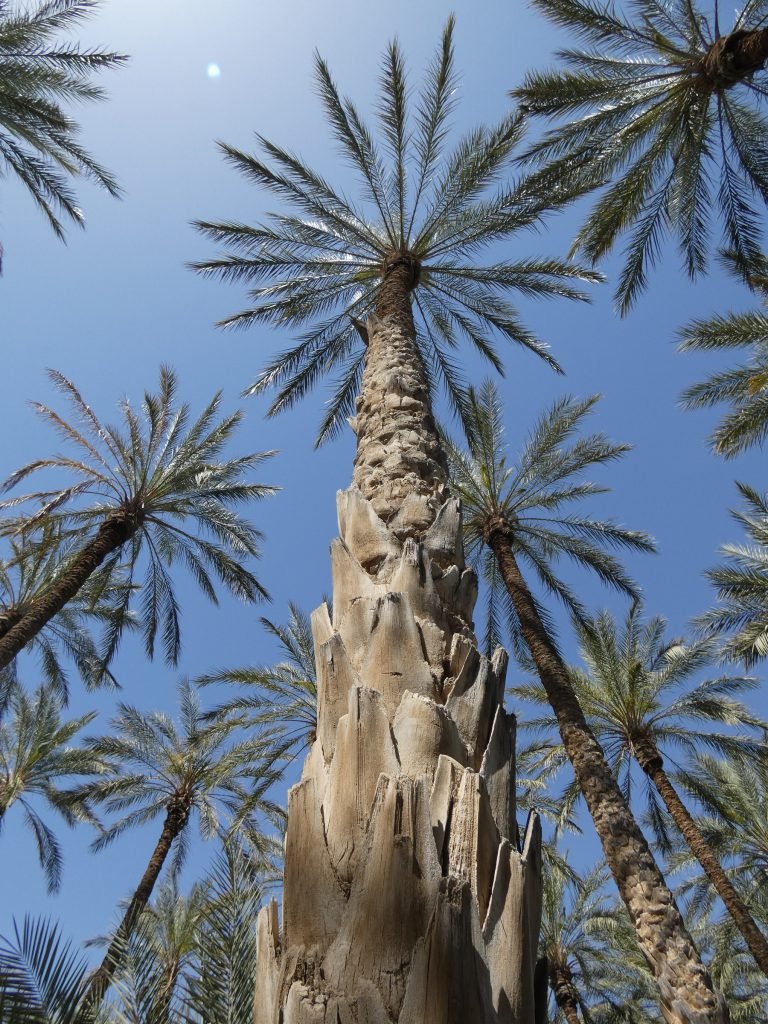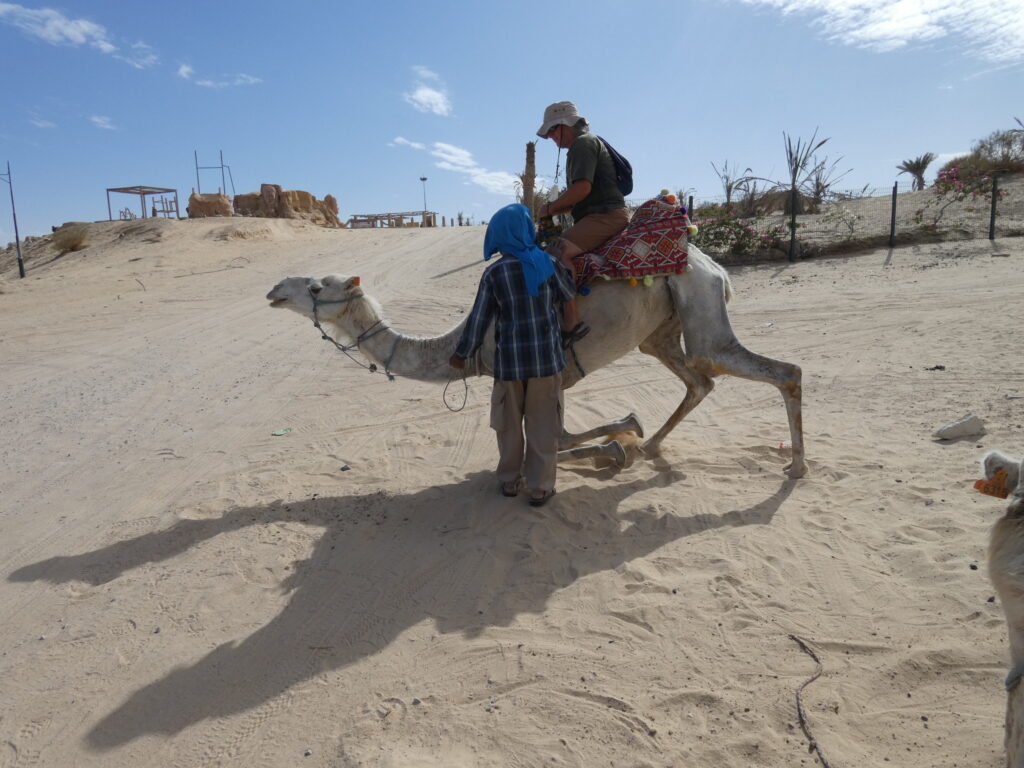We’d planned to take the train down to Tozeur in the south of Sardinia, a 6 hour journey leaving Sousse mid-morning. We’d be able to sit back, relax and enjoy the scenery whizzing by. However, the day before departure, we discovered that a Ramadan timetable was in place and the train we wanted wasn’t running, leaving only an overnight one.
Onto plan B – the bus. The big issue with the bus service is that there is scant information available; the majority of timetables posted at the bus station were in Arabic only, without even a French version. There are several bus companies, some of which do have websites but even they didn’t all show timetables, and there is no single source of consolidated timetable information. So, we were winging it when we arrived at Sousse bus station just after 13:00, with a hope that a 16:30 bus was going to run. Luck was shining on us that day however, there was a bus leaving right then! We ran to get on, grabbed a seat and we were off.
Outside the window, a flat landscape flashed by, mostly populated with olive trees and other crops. The roads were straight, but speed was regularly curtailed by speed bumps that lurk through every village, of which there seemed to be many. Further south, hills rose up and fell away and as we arrived at the outskirts of the desert our view was dominated by far reaching vistas of scrubby plants eking out what life they could take from the sandy earth.

Arrival at 17:30 in Tozeur coincided with rush hour. The hours before the daily breaking of the fast were manic wherever we went during Ramadan. The roads were full of traffic, scooters dodging and weaving the many people on foot, mostly men, that thronged around the small produce market. We were given a few bonjours and ca-vas and asked twice if we wanted a carriage ride.
Our hotel was close to this bustle, but on a quiet side street, and the room was cool. It seemed like we were the only ones staying for the night,

Midday at The Oasis
After breakfast, we met the hotel owner who suggested some trips with prices. We would ponder them whilst taking a walk around the oasis and also call into some tour organisers for comparisons.
It was shaping up to be a warm day, so the shade of the oasis was very welcome. We seemed to be the only tourists in town as we followed the road in a loop amongst the tall date palms. Channels ran amongst them with clear water flowing quickly, and unfortunately, litter was scattered all around. Donkeys and carts, scooters and ancient trucks passed us by, most of the drivers waved and called greetings to us. I was amazed at so much greenery in the desert.





We arrived at the Chek Wak park. In my head I had it down as being a sculpture park, so we went in for a look. Well, it was full of a kind of sculpture if plastic dinosaurs can be called that! We followed the trail as it guided us from prehistory to modern day, with audio in several languages. It’d be great place to take kids.









From the oasis we arrived at the medina, deserted now at midday. Sensible people were sheltering from the heat so we for once followed suit and took refuge in the air conditioned room.

From a Ship of the Sea to a Ship of the Desert
We were collected by our hotel owner and driven the few miles to our camel trek point on the edge of town. Two cream coloured camels were waiting, sat on the ground with colourful blankets and padding making up the seat. I was on first, leg over then up! It was quite smooth and fast. I then got to watch Colin, who managed it like a pro. I relaxed into the swaying motion and decided to call my camel Columbo because of it’s shuffling gait. Colin went for naming his Colin. We rode through a desert golf course (they’ll build them anywhere) and on out into sandy terrain, the camels feet perfect for the soft, mobile ground. In the distance, we could see the Great Salt Lake shimmering in the heat. We stopped for lots of photo shoots; Columbo was a poser, Colin took every opportunity to eat. We even had a little gallop, which was bouncy, hands gripped tight onto the wooden harness.









We finished our hour long trek at the sculture park which I’d mixed up with this morning’s history park. There was a huge eagle and several huge carvings of someone’s head, a là Mount Rushmore. We don’t know who he was, but he had a look of Donny Osmond about him. Teenage boys were swimming in a water hole that looked very inviting and a man was riding a beautiful Arabian horse around. We passed a large jasmine tree where we paused as our guide picked me some flowers whilst Colin (the camel, not the man) quickly chomped down as many as he could. The smell was divine and I kept them in a glass of water by the bed for the next few days.


For dinner that night we found a restaurant just around the corner that had a handful of other tourists in it. There was camel on the menu, so I decided to try it. Yes, I did feel guilty and slightly hypocritical given my views on horse meat, having been riding Columbo earlier. But, when else would I get to try some? Colin went for lamb, served in a sizzling hot pot, the lid sealed shut with pastry. It smelt and tasted delicious. I had my camel with a spicy couscous; to be honest the meat wasn’t overly flavoursome with the texture of brisket beef. Interesting to have tried it, but won’t again.
Dune Bashing
For our second day we took a guided day trip into the desert. Our driver arrived with his huge Nissan truck and we headed off north towards the Djebel el Negueb mountains and our first stop at Chebika. As we arrived, convoy of 4WD were leaving, so the abandoned village was free of crowds. We took a Berber guide, who was good fun and he pointed out items of interest we’d have otherwise missed. First we walked through the old Berber village, left after a catastrophic flood in 1969. He explained how the houses were built and what each room was for. Then up the hill, through a narrow gap in the rocks, explaining the geology as we went. There was a long seam of fossilised sea shells and we noted the folds in the rock where they had been been pushed upwards. We also learnt why the salt lakes are so salty – this whole area was once covered by sea.

Down into a crevasse we came to the spring water, bubbling from under a rock. It’s fresh, not salty, and travels hundreds of miles under the mountains. It was a beautiful place; frogs squeaked and plopped into the water as we walked by, palm trees reached skywards. We climbed up high for far reaching views towards Algeria and then followed the babbling brook back to the village.







Our next stop was a viewpoint with a roadside stall. The stall holder tempted us to try date palm juice which was very tasty. As we drank, we browsed the stall and saw a colourful kilim rug (a traditional Berber, hand woven carpet) the right size for the boat. I could have bought many, but we stopped at buying just the one.



Back on the road we stopped for photo shoots at a waterfall and the abandoned ruins of Tamerza, then on to the Mides canyon, right next to the Algerian border. The canyon was picturesque and can be walked but even despite some of our past forays in the midday sun, even I declared it too hot for walking today.


Back in Tamerza we went for lunch in a traditional restaurant. The smells were mouth watering as we entered and were shown to a shaded area next to a courtyard. We started with salads, bread and harissa followed by the best brik we’ve had so far. Main course was lamb oven cooked in a pot with roasted vegetables. Delicious. As we ate we watched two tortoises in the yard nibbling on their salad leaf lunch.

We drove back the way we’d come, the long, straight road over the salt plain. The heat and the lunch were conspiring to send me to sleep when we turned off at a gap in the road barriers and drove across a hard packed track. That woke me up! We bounced along, the 4WD truck now in it’s element and the views became more interesting. Mirages glistened in the distance, camels wandered and randomly, the walls of a castle atop a dune – the remains of a film set. I gave the wall a tap; plastic.

Now the fun part of the trip – riding the dunes. Nadar was grinning as he created our personal rollercoaster ride and I asked if he enjoyed his job – oh yes! he replied. We stopped for photos and I scooped up some sand, it was super soft as it ran through my fingers. I could see how it would easily be picked up by the wind and blown hundreds of miles before dropping onto us as it did over the winter.





Can You Feel the Force Luke?
Over the crest of the dune were small dots surrounded by miles and miles of creamy sand; the Star Wars set of Mos Espa, which appeared in the first two films. We were the only ones there and were greeted by a group of men, trying to get us to buy their wares. A young boy pushed a tiny, bedraggled desert fox into my hands.


You can take a camel ride, but we declined. We took photos, stuck our head in some buildings and pretended to have a light sabre fight. On the return to our truck, the sellers were now all resting in the shade. I imagine it’s a very hard life, particularly with the decrease in tourism. We drove back via a tarmac road which runs close to the set, so if you have your own car you can visit, but then you miss out on dune bashing.



At 20 years old, the Star Wars set has seen better days; a smaller site has already been reclaimed by the sands. I wonder if it will still be here in another 20?

Thunderstorms Happen in the Desert
We’d kept our travel plans loose with options to continue on by louage to the east, but three days of thunderstorms were forecast. Rain in the desert, who’d have thought it! So, late morning, we boarded a bus to Kairouan, to change there for Monastir. The return seemed interminable, with constant delays, a break stop and a police check on the driver’s papers. We fretted about how we would travel from Kairouan to Monastir and hoped the louages would still be running. On a plus, we took a more scenic route back than on the outward trip, the road running up along a ridge of mountains. The depths of this range is marked as off limits by the British Foreign and Commonwealth Office; this and the dark thunderclouds looming over them made them seem very dramatic.
We were lucky again – on arriving at Kairouan bus station, we were told a Monastir bound bus was leaving in twenty minutes. We boarded as fat plops of rain began to fall and an hour or so later we were home on Emerald.

Travel Information
In hindsight, a car would have been a much better option for seeing this area. Besides the camel and 4WD, there isn’t much else to do in the town; a car would have got us out to a few more sights. We could have combined the desert and camels into one day and travelled on sooner.
| Description | Cost in Tunisian Dinar |
| Bus Sousse to Tozeur | 17 per person |
| Camel Trek | 35 per person |
| Private tour of desert – 1 day | 300 |
The Social Media Bit: Want to Follow Us?
If you’d like to follow us on other social media platforms (Facebook, Instagram and YouTube), you can do so by using these links:
Or use the link below to track our voyage on NoForeignLand.com.
And finally, you can sign up to receive email notifications of new blogs using the subscribe box at the bottom of this page.
Thank you from Nichola & Colin


